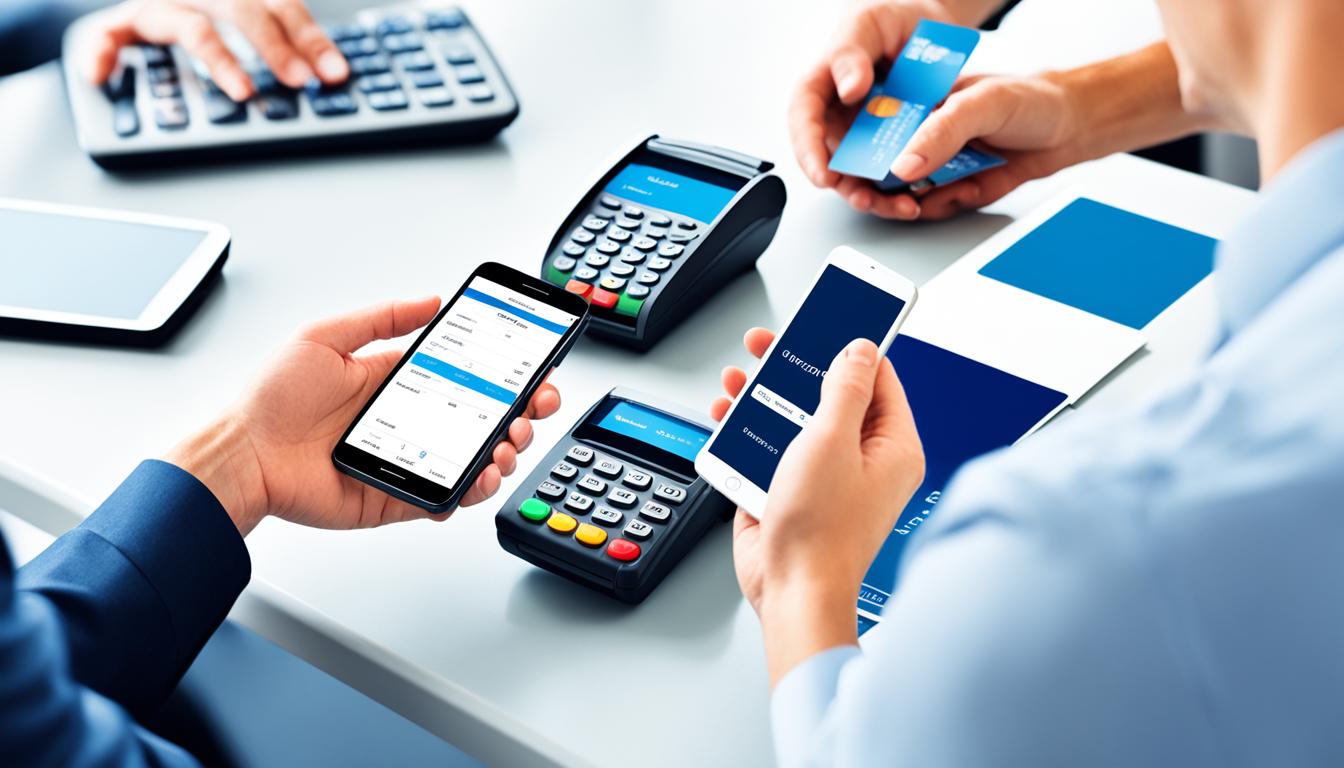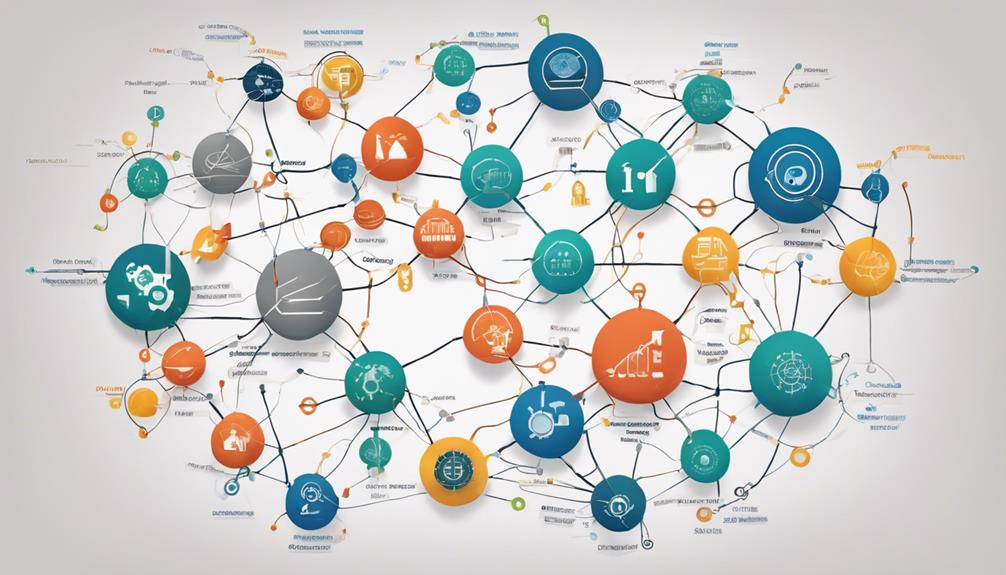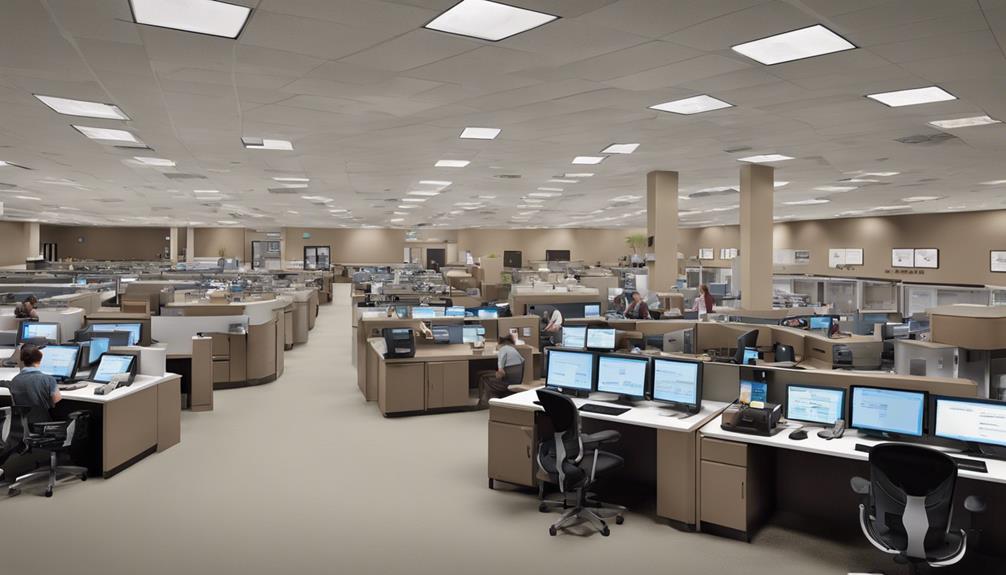In the United States, 79% of consumers in prefer using a credit or debit card for payments. As the demand for convenient payment methods continues to rise, it is essential for businesses to have a reliable and efficient checkout system in place. Two popular options that provide flexibility and convenience are mobile credit card processing and wireless credit card processing. These solutions enable businesses to accept payments on the move. To determine the most suitable choice for your business, it is important to assess the advantages and disadvantages of mobile and wireless credit card processing.
Key Takeaways:
- Mobile and wireless credit card processing offer convenience for businesses and customers.
- Mobile credit card processing allows merchants to accept payments through their cell phones.
- Wireless credit card processing involves using a wireless credit card machine to securely process transactions from anywhere.
- Understanding the differences between mobile and wireless credit card processing is crucial for choosing the right solution for your business.
- Consider factors such as transaction volume, compatibility with devices, and security when evaluating mobile and wireless credit card processing options.
How Wireless Processing Works
Wireless credit card processing is a convenient and efficient way for businesses to accept card payments without being tied down to a physical location. This section will explore the process of wireless credit card processing, highlighting the flow of transactions and the key players involved.
In wireless credit card processing, a wireless credit card machine is used to facilitate the transaction. When a customer is ready to make a purchase, the merchant slides their credit card in the wireless terminal and enters the sale amount.
The terminal then securely transmits the credit card information and purchase amount to the merchant services provider. This provider acts as an intermediary between the merchant and the customer’s issuing bank.
Once the merchant services provider receives the transaction details, they forward them to the issuing bank for validation. The bank checks the cardholder’s account balance and verifies the transaction’s legitimacy.
If the transaction is approved, the bank sends a response back to the merchant services provider. The provider then relays this response to the wireless credit card machine, completing the transaction.
The entire process typically takes around 10 seconds, allowing for quick and seamless transactions for both the merchant and the customer. This speed and convenience make wireless credit card processing a popular choice for businesses that need to accept payments on the go.
Wireless Credit Card Processing Flow:
| Step | Description |
|---|---|
| 1 | Merchant uses a wireless credit card machine to slide the customer’s card and enter the sale amount. |
| 2 | The wireless terminal securely sends the credit card information and purchase amount to the merchant services provider. |
| 3 | The merchant services provider forwards the transaction details to the issuing bank for validation. |
| 4 | The issuing bank checks the cardholder’s account balance and approves or declines the transaction. |
| 5 | If approved, the bank sends a response back to the merchant services provider. |
| 6 | The merchant services provider relays the approval response to the wireless credit card machine, completing the transaction. |
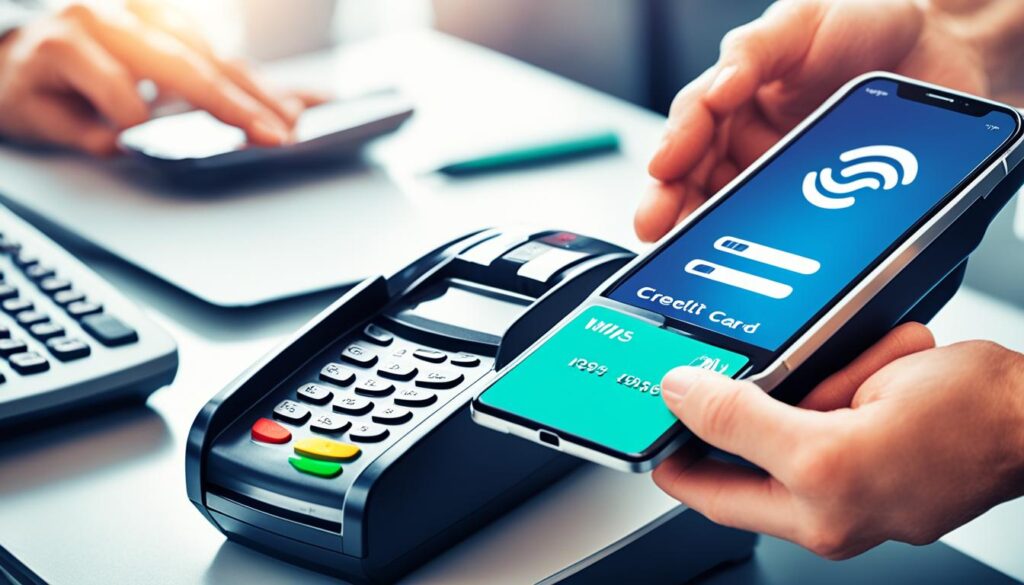
Understanding the flow of wireless credit card processing is essential for businesses considering this payment solution. In the next section, we will explore the differences between wireless credit card processing and mobile credit card processing, helping you choose the right option for your business needs.
Difference Between Wireless Credit Card Processing vs Mobile Credit Card Processing
While both wireless credit card processing and mobile credit card processing offer untethered checkout experiences, there are some key differences between the two. Understanding these differences will help you choose the right option for your business.
Wireless Credit Card Processing:
- Uses a wireless credit card terminal that works independently without needing a direct hookup to a phone line or Internet connection
- Offers flexibility and convenience for businesses with a physical location
- Provides mobility within a specific range, typically utilizing Wi-Fi, 3G, or 4G networks
- Ideal for businesses with fixed points of sale, such as retail stores or restaurants
- Allows for secure and seamless card transactions
Mobile Credit Card Processing:
- Allows merchants to accept payments through their cell phones, either with an app or additional equipment
- Offers flexibility for businesses on the go, such as food trucks, delivery services, or trade show vendors
- Enables secure transactions through encrypted technology
- Provides portability and the ability to accept payments from anywhere with cellular reception
- Requires compatible smartphones or tablets and a stable Internet connection
Consider your business needs, location, and operations when choosing between wireless credit card processing and mobile credit card processing.
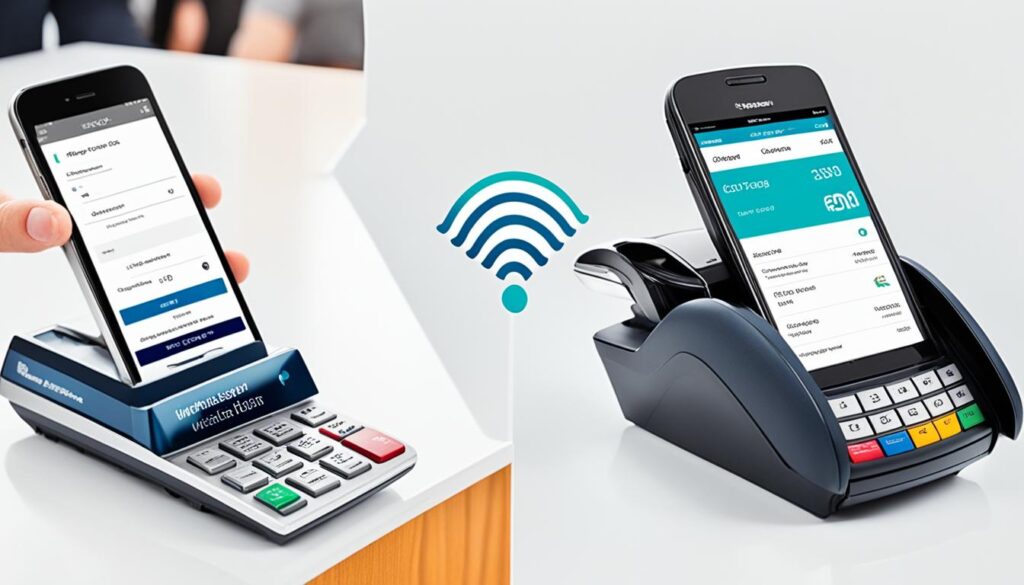
Comparison of Wireless Credit Card Processing and Mobile Credit Card Processing
| Features | Wireless Credit Card Processing | Mobile Credit Card Processing |
|---|---|---|
| Independence from Phone Line or Internet Connection | Yes | No, requires stable Internet connection |
| Physical Location | Fixed points of sale, such as retail stores or restaurants | Businesses on the go, such as food trucks, delivery services, or trade show vendors |
| Portability | Limited to a specific range within Wi-Fi, 3G, or 4G networks | Enables transactions from anywhere with cellular reception |
| Device Requirements | Wireless credit card terminal | Compatible smartphones or tablets |
| Transaction Security | Secure and seamless | Encrypted technology for secure transactions |
A Closer Look at Wireless Credit Card Machines
Wireless credit card machines play a crucial role in enabling seamless wireless credit card processing for businesses. These machines function similarly to traditional countertop terminals but offer the advantage of not requiring a direct power source. Instead, they can connect to a Wi-Fi network or have a monthly SIM plan for 3G and 4G networks, providing flexibility and convenience.
When it comes to wireless credit card machines, there are several popular options available in the market. Let’s take a closer look at two highly regarded models:
| Wireless Credit Card Machines | Features |
|---|---|
| PAX A920 | The PAX A920 is a versatile wireless credit card machine with a user-friendly touchscreen display. It also features a high-speed thermal printer, ensuring efficient and reliable transaction processing. With its advanced technology, the PAX A920 offers seamless payment experiences for both merchants and customers. |
| Dejavoo Z9 | The Dejavoo Z9 is another popular wireless credit card machine known for its EMV and NFC contactless capabilities. This machine allows customers to make secure payments using various technologies, providing convenience and peace of mind. It is a versatile solution for businesses seeking contactless payment options. |
These wireless credit card machines offer cutting-edge features and functionality, enabling businesses to process transactions efficiently and securely. The PAX A920 and Dejavoo Z9 are just examples of the many options available in the market. When choosing a wireless credit card machine, it’s important to consider the specific needs of your business and select a solution that best aligns with your goals and objectives.
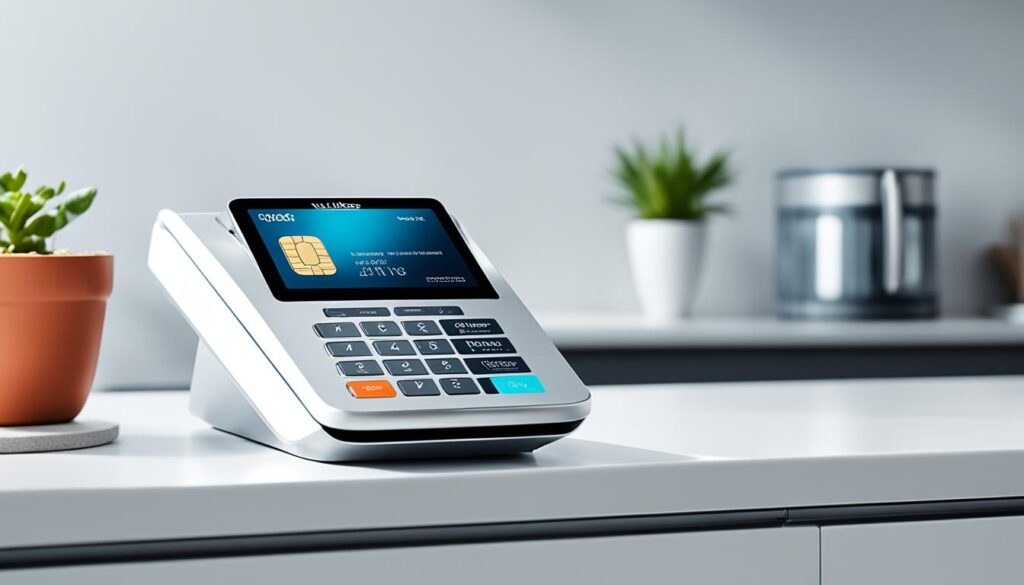
How Easy is it For Me to Add to My Business?
Adding a wireless payment system to your business can be a seamless process, and with providers like Stax, it becomes even easier. By incorporating wireless terminals into your operations, you can enjoy numerous benefits and improve your overall business efficiency.
Wireless terminals are designed to be flexible and adaptable, enabling you to process payments anywhere and at any time. They eliminate the need for traditional card readers and wired connections, reducing operating expenses and saving you valuable time. With a wireless payment system, you can provide a convenient and secure payment experience to your customers, offering the same level of security, flexibility, and reliability as other processing solutions.
This level of convenience is especially beneficial for businesses with mobile operations, such as outdoor venues, food trucks, and trade shows. By adding a wireless payment system, you can easily accept payments on the go, expanding your sales opportunities and catering to the preferences of your customers.
Take advantage of the benefits of wireless terminals and optimize your business with a wireless payment system today.
Benefits of Adding a Wireless Payment System:
- Flexibility to process payments anywhere and at any time
- Reduction in operating expenses
- Time-saving solution
- Enhanced convenience for customers
- Expanded sales opportunities for businesses with mobile operations
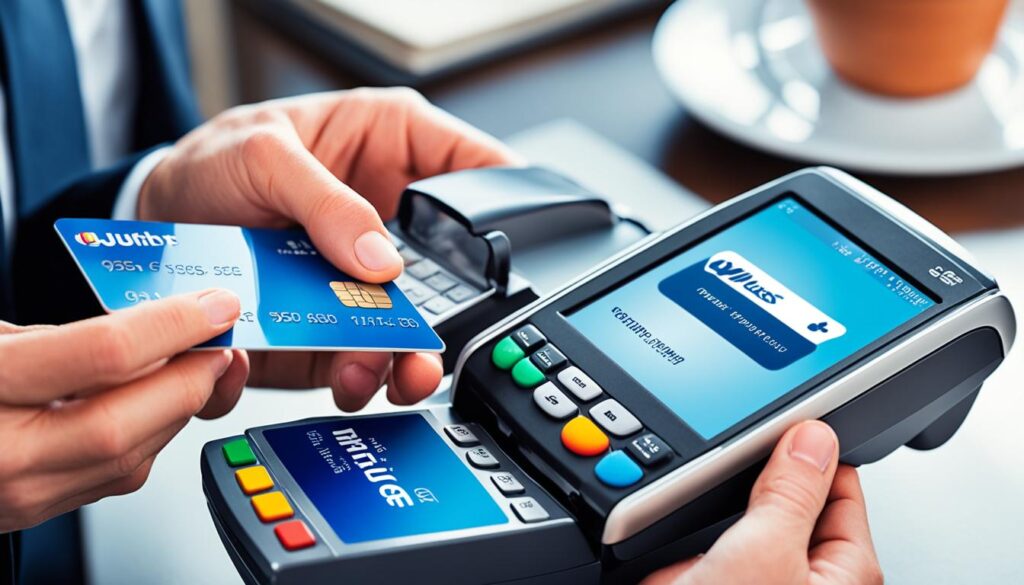
A Quote from a Satisfied Business Owner:
“Adding a wireless payment system to my business has been a game-changer. It has allowed me to effortlessly accept payments wherever I am, whether I’m at a trade show or serving customers at an outdoor event. The flexibility and convenience it offers have significantly improved my sales and customer satisfaction.” – Sarah Matthews, Owner of Sarah’s Food Truck
Pros & Cons: Mobile Credit Card Processing
Mobile credit card processing offers convenience and flexibility for businesses. With the right app or equipment, merchants can accept credit and debit cards through their cell phones. Let’s take a closer look at the pros and cons of mobile credit card processing:
Pros
- Easy setup: Mobile credit card processing is typically easy to set up and can be done quickly, allowing businesses to start accepting payments swiftly.
- Receipts through text or email: Merchants can easily send digital receipts to their customers through text messages or email, providing a seamless transaction experience.
- Portability: With mobile credit card processing, merchants have the freedom to accept payments anywhere, whether they’re at a trade show, a pop-up shop, or moving from table to table at a restaurant.
Cons
- Transaction volume limitations: Some mobile credit card processing solutions may have limitations on transaction volume, which can affect businesses processing large volumes of transactions.
- Compatibility with certain devices: Not all mobile credit card processing solutions are compatible with every mobile device. Merchants need to ensure that their chosen solution works seamlessly with their specific device.
- Security concerns: Mobile credit card processing raises potential security concerns, as mobile devices may be more susceptible to malware, data breaches, or theft. Merchants must implement stringent security measures to protect customer payment information.
In summary, mobile credit card processing offers several advantages for businesses, including easy setup, the ability to send receipts digitally, and unmatched portability. However, it’s essential to consider the limitations regarding transaction volume, device compatibility, and security concerns. By weighing the pros and cons, businesses can make an informed decision about integrating mobile credit card processing into their operations.
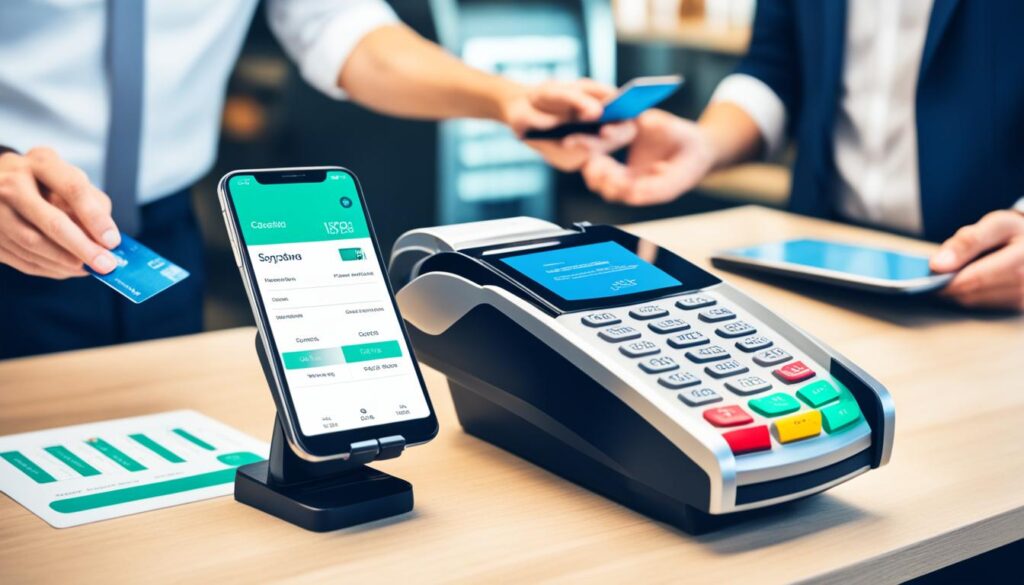
Our Top Picks for Mobile Credit Card Readers and Processors
When it comes to choosing the best mobile credit card reader and processor for your business, there are several top picks to consider. These options offer a range of features and pricing plans, allowing you to find the best fit for your specific business needs.
Square
Square is a leading mobile credit card reader and processor that offers a complete solution for small businesses. With Square, you can accept payments from anywhere using your smartphone or tablet. Their reader is easy to use, and they offer competitive pricing with no monthly fees.
Clover Go
Clover Go is a popular mobile credit card reader that works seamlessly with Clover’s suite of business management tools. With Clover Go, you can accept payments on the go, manage your inventory, and access valuable sales insights. It’s an all-in-one solution for small businesses.
PayPal Zettle
PayPal Zettle is a trusted name in the payments industry, and their mobile credit card reader and processor is a great choice for small businesses. With PayPal Zettle, you can accept all major card types and manage your transactions through their user-friendly app. They also offer competitive pricing and fast access to your funds.
QuickBooks GoPayment
QuickBooks GoPayment is an ideal choice for businesses already using QuickBooks for their accounting needs. With QuickBooks GoPayment, you can seamlessly sync your sales and payments data, making it easy to keep track of your finances. Their mobile credit card reader is reliable and easy to use.
Payanywhere
Payanywhere is a feature-rich mobile credit card reader that offers competitive pricing and robust reporting tools. With Payanywhere, you can accept payments securely and conveniently, whether through their card reader or their virtual terminal. They also offer customizable receipts and real-time sales tracking.
Helcim
Helcim is known for its transparent pricing and excellent customer service. Their mobile credit card reader and processor offer a wide range of features, including robust reporting tools, customizable receipts, and integrated invoicing capabilities. Helcim is a great option for businesses looking for reliable and affordable payment processing.
Solo Card Reader
Solo Card Reader is a compact and affordable mobile credit card reader that is easy to use and offers competitive pricing. With Solo, you can accept payments securely through your smartphone or tablet and access real-time reporting. It’s a great choice for small businesses looking for a simple and reliable solution.
These are just a few of our top picks for mobile credit card readers and processors. Remember to consider your business needs, budget, and desired features when choosing the best option for you.
| Mobile Credit Card Reader | Key Features |
|---|---|
| Square | No monthly fees, easy-to-use reader, competitive pricing |
| Clover Go | Seamless integration with Clover’s business management tools, accept payments on the go |
| PayPal Zettle | Trusted name, accepts all major card types, fast access to funds |
| QuickBooks GoPayment | Syncs with QuickBooks, reliable and user-friendly, seamless payment tracking |
| Payanywhere | Feature-rich, customizable receipts, real-time sales tracking |
| Helcim | Transparent pricing, robust reporting tools, excellent customer service |
| Solo Card Reader | Compact and affordable, easy to use, real-time reporting |
How Do Credit Card Machines Work?
Credit card machines play a crucial role in collecting payments from customers who prefer to pay with credit or debit cards. Understanding how these machines function is essential for businesses seeking to efficiently process payments and provide a seamless checkout experience.
Credit card machines are typically connected to the internet or a phone line, allowing them to send payment data securely to the processor. Once a customer swipes or inserts their card and enters the sale amount, the machine captures the necessary information and securely transmits it to the merchant services provider.
Through a series of encrypted connections, the merchant services provider forwards the transaction details to the customer’s issuing bank for validation. The bank checks the customer’s account balance, verifies the transaction, and approves or declines it accordingly.
If the transaction is approved, the funds are transferred from the customer’s bank account to the business’s merchant account. Alternatively, the processor may temporarily hold the funds and then deposit them into the business’s account at a later time, depending on the specific payment processing arrangement.
Here is a simplified overview of the process:
- The customer swipes or inserts their credit or debit card into the machine.
- The machine captures the card information and sale amount.
- The machine securely sends the transaction details to the merchant services provider.
- The merchant services provider forwards the information to the issuing bank for validation.
- The bank verifies the transaction and approves or declines it.
- If approved, the funds are transferred from the customer’s bank account to the business’s merchant account or held by the processor for later deposit.
Understanding the intricacies of credit card machines allows businesses to implement efficient payment processing systems and provide a seamless experience for their customers.
| Advantages | Challenges |
|---|---|
| Credit card machines offer a secure and reliable method for collecting payments. | Some customers may be hesitant to use credit cards due to security concerns. |
| The transaction process is quick, typically taking only a few seconds to complete. | Businesses must acquire and maintain credit card machines, incurring costs. |
| Credit card machines support various payment methods, including chip and contactless transactions. | Technical issues or network outages can interrupt the payment process. |
| The machines provide detailed transaction records for accounting and reconciliation. | Businesses must adhere to strict compliance and security standards to protect sensitive customer data. |
Types of Credit Card Machines
When it comes to accepting credit card payments, businesses have several options for credit card machines. Each type of machine is designed to cater to different business needs and requirements. Let’s take a closer look at the most common types of credit card machines available:
1. Countertop Terminals
Countertop terminals are the traditional credit card machines often seen in brick-and-mortar stores. They are connected to a power source and a phone line or internet connection, allowing for fast and secure transactions. Countertop terminals are easy to use and can handle high transaction volumes, making them ideal for businesses with a fixed point of sale.
2. Mobile Terminals
Mobile terminals provide flexibility for businesses on the go. These handheld devices connect wirelessly to a cellular network or Wi-Fi, allowing merchants to accept payments wherever they are. Mobile terminals are lightweight and portable, making them perfect for businesses that operate in various locations such as food trucks, delivery services, and trade shows.
3. Virtual Terminals
Virtual terminals are software-based solutions that allow businesses to process credit card payments through a secure online portal. They are commonly used by e-commerce businesses and provide a convenient way to accept payments without the need for physical card-present transactions. Virtual terminals are accessed through a web browser, making them accessible from any device with an internet connection.
4. Integrated POS Terminals
Integrated POS terminals combine credit card processing hardware with a point-of-sale (POS) system. These all-in-one solutions streamline transactions by allowing businesses to process payments, manage inventory, and generate sales reports from a single device. Integrated POS terminals are commonly used in retail and hospitality industries, providing a comprehensive solution for businesses that require a full range of management tools.
Choosing the right type of credit card machine depends on your business’s specific needs and operations. Consider factors such as the nature of your business, mobility requirements, transaction volume, and integration with other systems. By selecting the most suitable credit card machine, you can enhance the efficiency of your payment processing and provide a smooth checkout experience for your customers.
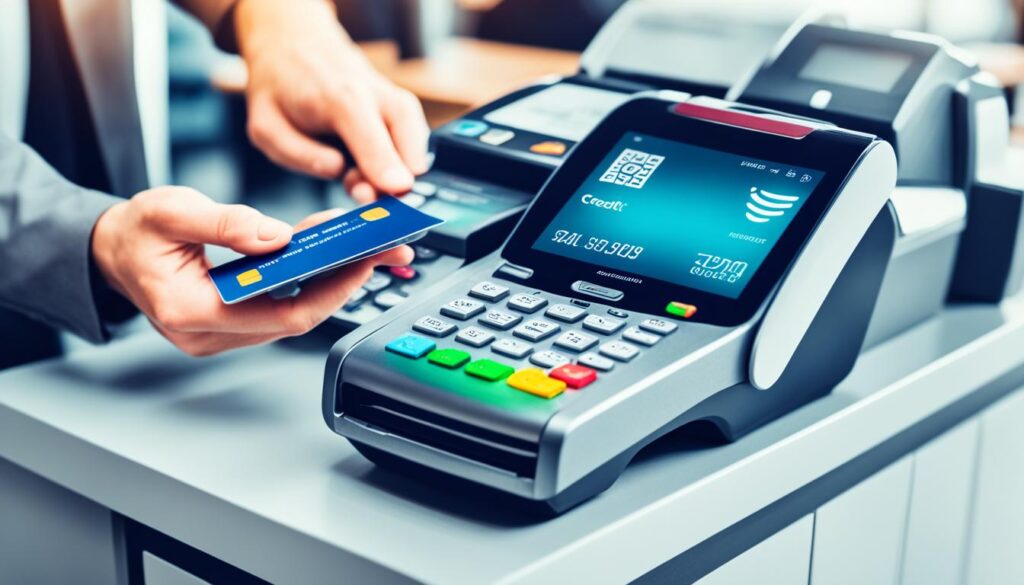
Credit Card Machines vs POS Systems
When it comes to processing card payments, businesses have two main options to choose from: credit card machines and POS systems. While credit card machines focus solely on processing payments, POS systems offer a more comprehensive checkout experience with additional features.
Credit Card Machines:
A credit card machine, also known as a credit card terminal, is a standalone device used to collect payments from customers who prefer to pay by credit or debit card. These machines are typically connected to the internet or a phone line to transmit data to the payment processor. The funds are then transferred from the customer’s bank to the business’s merchant account or held by the processor until deposited into the business’s account at a later time.
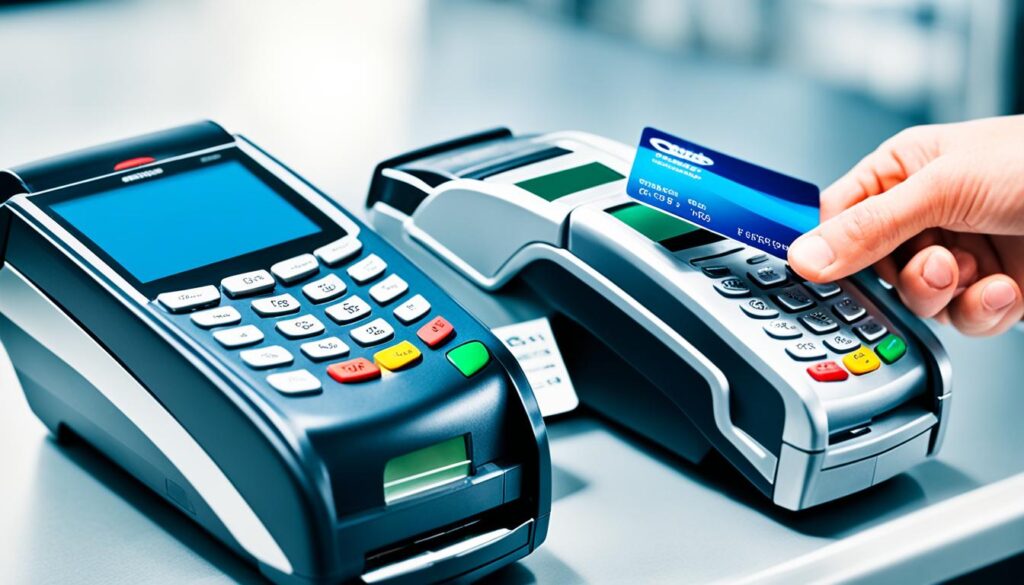
Pros of Credit Card Machines:
- Specifically designed for processing card payments
- Reliable and secure transaction processing
- Fast and efficient payment collection
Cons of Credit Card Machines:
- Limited functionality beyond payment processing
- May require additional equipment or software for more advanced features
- Less comprehensive reporting and analysis capabilities
POS Systems:
A POS (Point of Sale) system combines a credit card machine with a range of additional features, creating a complete checkout terminal. In addition to processing payments, POS systems offer inventory tracking, sales analysis, customer management, and other tools to streamline business operations. These systems can be either hardware-based, with a terminal and other equipment, or software-based, running on a computer or mobile device.
Pros of POS Systems:
- Complete solution for managing sales, inventory, and customer data
- Advanced reporting and analytics capabilities
- Integration with other business management tools (e.g., accounting software)
Cons of POS Systems:
- More complex setup and implementation
- Higher initial cost and ongoing expenses
- Requires staff training to utilize the system effectively
While credit card machines serve as a component of POS systems, it’s important to understand that POS systems offer a more comprehensive solution for businesses. POS systems provide not only payment processing capabilities but also advanced features to help streamline operations, improve efficiency, and enhance the customer experience.
Ultimately, the choice between a credit card machine and a POS system depends on the specific needs and priorities of a business. If you require only basic payment processing, a credit card machine may be sufficient. However, if you’re looking for a more robust and versatile solution that offers enhanced functionality and actionable insights, a POS system would be the better choice.
Recommended POS Systems and Credit Card Processors
When it comes to choosing a POS system or credit card processor for your business, it’s important to consider your specific needs and preferences. With various providers available in the market, finding the right solution can be overwhelming. To help you make an informed decision, here are some recommended options:
- Square
- Clover POS
- Toast
- Lightspeed
- TouchBistro
These providers offer a range of features, pricing plans, and hardware options to meet the diverse needs of different businesses. Square, for example, is known for its user-friendly interface and affordable payment processing rates. Clover POS offers a comprehensive solution with inventory management and customer relationship management capabilities. Toast specializes in the restaurant industry, offering features like tableside ordering and menu customization. Lightspeed is ideal for retail businesses, providing inventory management and e-commerce integration. TouchBistro caters specifically to restaurants and offers features like tableside ordering and bill splitting.
Evaluating the best POS systems and credit card processors will help you find the perfect fit for your business, optimizing checkout efficiency and improving the overall customer experience.
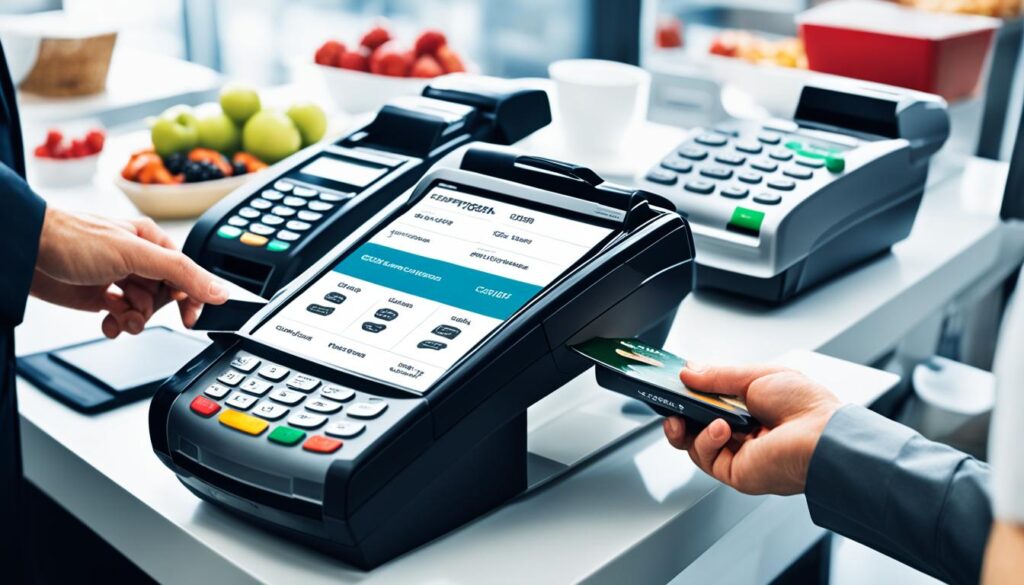
Conclusion
Mobile vs wireless credit card processing provides businesses with the flexibility and convenience of accepting card payments. When deciding between the two options, it is essential to consider the specific needs and operations of the business. Understanding the workings of wireless credit card processing and mobile credit card processing, as well as the range of credit card machines and point of sale (POS) systems available, is crucial in making an informed decision.
By evaluating recommended options, considering features, and comparing pricing plans, businesses can select the solution that best suits their requirements. This allows them to enhance payment flexibility and improve the overall checkout experience for customers.
A thorough assessment of pros and cons, an understanding of how these technologies function, and familiarity with the various available options will empower businesses to make an informed decision, optimizing their operations and meeting the needs of their customers.
